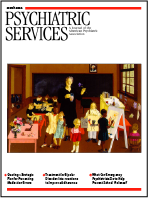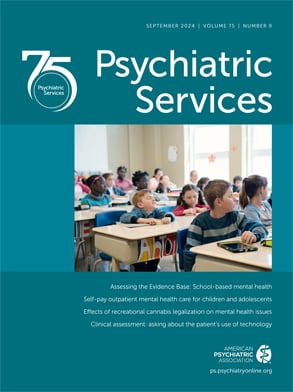There is a high prevalence of long-term benzodiazepine use among elderly persons (persons aged 65 years or older), who account for 12.5 percent of the general population. This topic merits attention given that this segment of the population is expected to grow and given that elderly persons are particularly prone to adverse reactions to benzodiazepines. In this column we review the literature on the extent of benzodiazepine use and dependence among elderly persons and specific problems that arise.
Prevalence of use
Thirty percent of all prescription drugs are prescribed for elderly persons, and many of these medications are psychotropics (
1). Of the available sedative-hypnotic drugs, benzodiazepines are by far the most frequently prescribed (
2).
In a study by Morgan and colleagues (
3), the prevalence of use of hypnotic drugs (92 percent of these being benzodiazepines) among persons aged 65 years or older in a nationally representative British sample was 16 percent. Use of hypnotics was more prevalent among women than men and increased significantly with age. The rate of use was 13 percent among persons aged 65 to 74 years and 20 percent among those aged 75 years or over. Durations of use were from one to five years in 13 percent of the sample, from five to ten years in 19 percent, and for more than ten years in 25 percent. Two other studies—one from Europe and one from Quebec—showed prevalence rates of 19.8 percent and 23 percent for continuous use of benzodiazepines among older adults (
4,
5).
Benzodiazepines are even more frequently prescribed for elderly patients who are institutionalized. Data from the United States National Nursing Home Survey indicated that of all the psychotropic drug prescriptions for patients aged 65 years or older in 1984, 41 percent were antianxiety agents, mainly benzodiazepines (
6). Another study of psychotropic drug prescription in nursing homes showed that 32 percent of prescriptions were anxiolytics (
7).
Several problems in drug prescribing for elderly patients have been documented, including inadequate clinical assessment, excessive prescribing, and altered pharmacokinetics and pharmacodynamics (
8).
Pharmacokinetics and pharmacodynamics
With advancing age, elderly persons are more sensitive to the potential side effects of benzodiazepines because of altered pharmacokinetics and pharmacodynamics. Numerous studies of benzodiazepine kinetics have been conducted and have shown that alterations in the distribution and elimination of these agents occur among older patients. Benzodiazepines with oxidative pathways and longer half-lives, such as chlordiazepoxide, diazepam, and flurazepam, are more likely to accumulate in the body and cause prolonged sedation (
10).
Furthermore, alterations in pharmacodynamics rather than pharmacokinetics among elderly patients can be more important in explaining the altered response to benzodiazepines. The increased sensitivity of older people to benzodiazepines is due to age-related alterations in the central nervous system receptors. It is likely that benzodiazepine receptors in the brain become more sensitive, causing increased sedation, unsteadiness, memory loss, and disinhibition. Psychomotor studies among elderly patients using benzodiazepines indicate that this patient group, especially those with dementia, hypoalbuminemia, or chronic renal failure, have a greater risk of sedation. The simultaneous use of multiple medications increases the risk of adverse drug reactions (
11).
Adverse effects
Investigation of drug-associated hospital admissions among older patients has shown that up to 10 percent may be due to benzodiazepines (
12). Adverse drug reactions may be experienced to a greater extent by benzodiazepine-dependent patients, who use benzodiazepines over a prolonged period and use them more frequently (
12).
The use of benzodiazepines among elderly patients has been associated with intellectual and cognitive impairment (
13). Cognitive impairment is characterized by anterograde amnesia, diminished short-term recall, and increased forgetfulness. These symptoms are consistent with the early stages of dementia but are also characteristic of normal aging. Cognitive impairment seems to develop insidiously as a late complication of benzodiazepine use. Long-acting benzodiazepines are most commonly associated with cognitive impairment. Elderly patients with cognitive impairment show improved functioning once the drug has been discontinued (
13).
Benzodiazepines may contribute to psychomotor impairment and increase the risk of falls and automobile accidents (
14). Psychomotor impairment is characterized by slowed reaction time and diminished speed and accuracy of motor tasks. Several studies showed evidence for increased risk of hip fracture and recurrent falls among elderly patients taking benzodiazepines. The risk of falls has been associated with sudden increases in dosage and with continuous use of benzodiazepines (
14).
Benzodiazepine abuse and dependence
Elderly patients frequently use benzodiazepines over a prolonged period. Chronic pain, depression, and isolation are common problems among elderly persons that can predispose them to benzodiazepine use and dependence. The risk of dependence among elderly persons increases with age and is more common among patients with medical conditions that require multiple medications and among patients who have depression and alcohol dependence (
9).
However, not all patients who are taking benzodiazepines for long periods become dependent. Benzodiazepine dependence in general can be more problematic among elderly persons, because tolerance to alcohol and benzodiazepine decrease with age. Substance dependence, particularly benzodiazepine dependence, is often underrecognized and not well documented among elderly persons. Barriers to diagnosis include inadequate self-reporting and misinterpretation of physical symptoms of dependence and withdrawal as normal consequences of aging. Dementia, depression, and anxiety syndromes are sometimes a consequence of benzodiazepine dependence. Commonly used questionnaires for detecting dependence are much less sensitive in the elderly population. Also, social markers, such as marital problems or work difficulties, may not be applicable to the elderly, who no longer drive, are retired, and often live alone.
To our knowledge only a few studies have assessed the prevalence of benzodiazepine abuse in the geriatric outpatient population (
15,
16,
17). Two studies did not find a single case of abuse (
15,
16). Both studies had several limitations, including extensive exclusion criteria, the investigators' reliance on the subjects' feelings toward their benzodiazepine use and their self-reported amount and frequency of use, and determination of presence or absence of substance abuse by chart review and interviews with treating physicians.
In the third study, by Holroyd and colleagues (
17), it was hypothesized that the prevalence of use of benzodiazepines and other substances was higher than rates reported in previous studies. The investigators used a method that limited selection bias and assessed benzodiazepine dependence by using diagnostic interviews and
DSM-III-R criteria. The prevalence of benzodiazepine dependence in that study was 11.4 percent. The findings suggest that the prevalence of substance use disorders in the geriatric outpatient population is significantly higher than previously reported.
In a retrospective study by Whitcup and associates (
18), 21 percent of patients aged 65 years or older who were admitted to a psychiatric unit had a diagnosis of substance dependence. A majority of substance-dependent patients had a diagnosis of benzodiazepine dependence. The results of this study emphasized the importance of detection of substance dependence among elderly persons, particularly benzodiazepine dependence, given that unrecognized substance dependence may lead to inappropriate and inefficient treatment. The study also showed that women appear to be at greater risk of misdiagnosis and undertreatment: benzodiazepine dependence went unrecognized among 75 percent of the women. The greater risk of misdiagnosis among women may be because women tend to use benzodiazepines rather than alcohol, which more often alerts the physician to the possibility of substance dependence.
Withdrawal
Benzodiazepine dependence is also characterized by a predictable discontinuation syndrome. Withdrawal is likely to occur after abrupt cessation of benzodiazepines or a significant sudden decrease in the absolute dosage among dependent patients. Symptoms of withdrawal include agitation, anxiety, dysphoria, increased awareness of sensory stimuli, perceptual disturbances, depersonalization, confusion, delirium, and seizures. Symptoms of withdrawal among elderly patients may be different from those seen among younger patients. In a prospective study of benzodiazepine use and withdrawal among elderly medical inpatients, confusion and disorientation with or without hallucinations were predominant symptoms of withdrawal after benzodiazepines were stopped abruptly. The elderly patients in that study did not develop other withdrawal symptoms, such as anxiety, insomnia, and perceptual changes (
19).
Gradual tapering of benzodiazepines has been shown to be at least as effective among elderly patients as among younger patients. Schweizer and colleagues (
20) compared the severity of withdrawal symptoms and clinical outcomes in a matched sample of elderly and young patients. The elderly patients showed significantly less severe withdrawal symptoms during a gradual taper and did as well in terms of outcomes as their younger counterparts. The authors speculated that a slower clearance of the medication may attenuate withdrawal symptoms and that diminished neuronal capacity among elderly persons causes less rebound overactivity.
Conclusions
Benzodiazepines are frequently prescribed for elderly patients. Opinion about their use is divided among experienced clinicians. A review of the literature leads us to conclude that benzodiazepines should be prescribed with caution, at low doses, and for short periods.
Short-half-life benzodiazepines, such as oxazepam, alprazolam, and triazolam, are usually recommended for older adults, because these agents do not accumulate in the blood, are rapidly cleared from circulation, and offer greater dosage flexibility. Short-half-life benzodiazepines may be associated with a clinically significant discontinuation syndrome and have a higher potential for abuse. Studies of extended-release alprazolam have shown less potential for abuse. However, no studies have been conducted of the use of extended-release alprazolam among elderly persons. Adverse reactions to benzodiazepines are more common among elderly patients and occur more frequently with advancing age. Dosages that may have a therapeutic effect for a 65- to 70-year-old patient can produce significant side effects among patients aged 75 years or older.Benzodiazepine dependence is a serious problem among elderly persons. Further research is needed to better characterize the risk factors and potential markers for benzodiazepine abuse among elderly persons. Clinicians should be aware of the prevalence of benzodiazepine dependence in this population in order to prevent, detect, and treat this problem.

